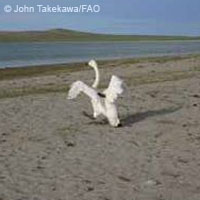International project tracks progression of avian flu
A new scheme, run by the Rome-based Food and Agriculture Organization of the United Nations (FAO), uses a global positioning system (GPS) to track migrating birds in order to understand how avian flu spreads. EU Member States foot 30 per cent of the project's bill. When birds are discovered with the H5N1 virus, entire flocks are destroyed to prevent the virus spreading further. Humans can contract the virus when in close contact with infected birds, and the mortality rate stands at more than 50 per cent. Some researchers are concerned that should the virus mutate, enabling human to human spread, then a lethal flu pandemic could ensue. But, by the time the news reaches us of an infected flock, the virus has done its work, and we learn about the evidence of that spread. To understand how the virus could infect a flock of battery hens, we have to understand the migrating patterns of birds. In May, a meeting between the FAO and the World Organisation for Animal Health decided to improve our knowledge of the behaviour of migrating birds, and more importantly, how these birds interact with domestic or commercial flocks. The FAO-led team is in Mongolia, attaching miniature GPS units to migrating swans in order to follow their winter migrations. 'We are working to understand the role wild birds may play in the spread of H5N1,' said Dr Scott Newman, FAO's Rome-based International Wildlife Coordinator for avian flu for. 'Although poultry and bird trade are probably the primary routes of movement, migratory birds are likely involved in some areas.' The FAO, working with the US government's Geological Survey, the Wildlife Conservation Society (WCS) and Mongolian Academy of Sciences, chose the whooper swan to study, as large numbers died during the annual migration west in the winter of 2005/2006. 'The whooper swan project in Mongolia demonstrates the importance that FAO places on understanding the relationship between agricultural, wildlife, and human health,' said Dr Newman. Because flocks of migratory birds are so large, it has been difficult to monitor with any precision which birds go where for the winter until now. New technology has allowed the researchers to develop a small solar-powered GPS 'backpack' for the swans, recording their location. The backpack will eventually drop off, but not before it has yielded important information about the bird's migratory patterns. EU Member States contributing to the project are: France, Germany, Italy, the Netherlands, Spain, Sweden and the UK.
Countries
Germany, Spain, France, Italy, Mongolia, Netherlands, Sweden, United Kingdom, United States



